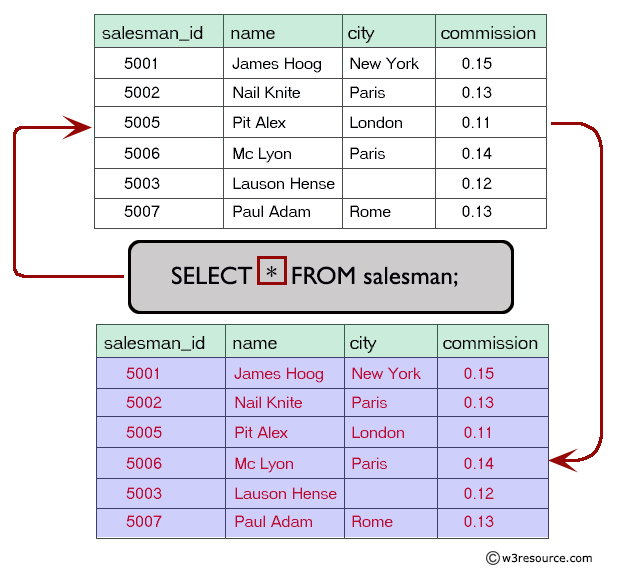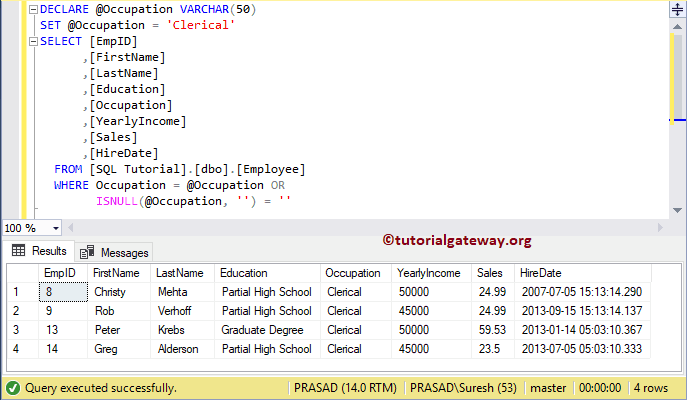Database tables are objects that stores all the data in a database. In a table, data is logically organized in a row-and-column format which is similar to a spreadsheet. The data is returned in a table-like structure called a result-set. ALL, ANY and SOME Comparison Conditions in SQL. How do I perform an IF.
APPLIES TO: SQL Server Azure SQL Database Azure Synapse Analytics ( SQL DW) Parallel Data Warehouse. Retrieves rows from the database and enables the selection of one or many rows or columns from one or many tables in SQL Server. Nella lezione precedente abbiamo esaminato i costrutti che SQL mette a disposizione per inserire i dati in un database relazionale.
In questa e nelle prossime lezioni ci concentreremo sulle istruzioni che ci permettono di estrarre i dati che ci interessano. When used as a substitute for explicit column names, it returns all columns in all tables that a query is selecting FROM. This effect applies to all tables the query accesses through its JOIN clauses. SELECT SUM() FROM (SELECT (SELECT ()). The following example shows three code examples.

These allow you to easily view a wide variety of metadata for this particular SQL Server instance, including information about COLUMNS, ROUTINES, and even TABLES. Scopo dei comandi del linguaggio SQL. Un uso frequente dei comandi SQL è la selezione dei dati dalle tabelle che si trovano in un database. In this tutorial you will learn how to select records from database tables using SQL.
Selecting Data from Table. A query may retrieve information from specified columns or from all of the columns in the table. List all indexes for all tables in a SQL Server database. To list all indexes for all user tables in a database,.

The SQL UNION ALL operator does not remove duplicates. Now I am not interested in the data in this table, what I am interested in is just the schema. SI APPLICA A: SQL Server Database.
DISTINCT will eliminate those rows where all the selected fields. La differenza tra UNION ALL e UNION consiste nel fatto che, mentre UNION consente di selezionare solo valori distinti, mediante UNION ALL è possibile selezionarli tutti. FROM WHERE, HAVING, GROUP BY, ORDER BY are optional. However, you always need to combine several clauses together to construct practical queries.

IT would be very convenient for selecting all the non-blob or non-geometric columns from a table. Non SQL Server databases use keywords like. You can check the PROC SQL macro variable SQLOBS to see the number of rows that are produced by a query-expression.
See Using the PROC SQL Automatic Macro Variables in the SAS 9. This is one of a set of articles about Access SQL. For an overview of Access SQL , see the article Access SQL : basic concepts, vocabulary, and syntax. SQL (acronimo di Structured Query Language) è il linguaggio di interrogazione più diffuso tra quelli usati per l’interazione con i principali Database Management Systems (DBMS), soprattutto relazionali. Chi ha necessità di utilizzare database sul proprio server, non può prescindere dalla conoscenza di SQL.

This SQL tutorial explains how to use the SQL IN condition with syntax and examples. The SQL IN condition (sometimes called the IN operator) allows you to easily test if an expression matches any value in a list of values.
Nessun commento:
Posta un commento
Nota. Solo i membri di questo blog possono postare un commento.